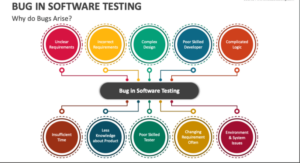Introduction
Quality assurance (QA) is a crucial part of software development, ensuring applications function correctly before release. Two vital testing techniques in QA software testing courses are retesting and regression testing. Many QA beginners often confuse these terms, assuming they are interchangeable. However, they serve different purposes in software testing.
In this blog, we will clarify the differences between retesting and regression testing, explain their real-world applications, and why mastering them is essential for a successful career in software testing. If you are considering QA tester training, this guide will help you understand these key concepts.
What is Retesting?
Retesting is the process of verifying a defect fix by running the failed test cases again. The primary goal of retesting is to check whether a previously identified bug has been resolved after applying the fix.
Key Features of Retesting
- Performed only for specific test cases that previously failed.
- Focuses on verifying bug fixes.
- Conducted in the same testing environment as the defect discovery.
- Does not involve testing unaffected areas of the application.
- Generally performed manually.
Example of Retesting
Imagine an e-commerce application where the checkout button was not working due to a JavaScript error. The developer fixes the issue, and the tester re-executes the failed test case to ensure the button now functions correctly. This process is retesting.
What is Regression Testing?
Regression testing ensures that recent code changes do not negatively impact existing functionalities. Unlike retesting, which focuses on specific bug fixes, regression testing examines whether the software works as expected after updates.
Key Features of Regression Testing
- Ensures that new code changes do not introduce new defects.
- Performed on a broader scope, covering related functionalities.
- Can be automated for efficiency and consistency.
- Essential after enhancements, bug fixes, or configuration changes.
- Helps maintain software stability.
Example of Regression Testing
Continuing with the e-commerce application example, suppose the development team introduces a new discount feature. After implementing the discount, testers need to ensure that the checkout button, payment gateway, and order confirmation functionalities still work as expected. This process is regression testing.
Differences Between Retesting and Regression Testing
To clarify the differences, let’s compare retesting and regression testing side by side:
| Feature | Retesting | Regression Testing |
|---|---|---|
| Purpose | Verifies bug fixes | Ensures new changes don’t break existing functionality |
| Scope | Specific failed test cases | Broader coverage, including modified and related features |
| Automation | Generally manual | Often automated |
| Execution Time | Performed after defect fixes | Conducted after changes, updates, or bug fixes |
| Test Cases | Uses failed test cases | Includes previously passed test cases |
| Objective | Ensures reported defects are fixed | Checks software stability after modifications |
Why Are Retesting and Regression Testing Important in QA?
Both testing approaches play a crucial role in software development. Here’s why they are essential in a QA software tester course:
- Ensuring software reliability: Retesting ensures reported defects are fixed, while regression testing verifies that new updates do not break existing functionality.
- Enhancing software quality: Identifying and fixing defects at different levels reduces system crashes and user dissatisfaction.
- Boosting efficiency: Automated regression testing speeds up software releases while maintaining stability.
- Supporting agile development: Frequent software changes require constant validation, making regression testing indispensable in agile environments.
Automating Regression Testing for Better Efficiency
Manual regression testing can be time-consuming, especially for large applications. That’s why most companies automate regression testing using tools like:
- Selenium – Popular for web-based application testing.
- JUnit – Used for Java-based applications.
- TestNG – Advanced testing framework for automation.
- Appium – Best for mobile app testing.
- Katalon Studio – Simplifies test automation with an easy-to-use interface.
Industry Case Study: The Role of Regression Testing in Facebook Updates
Social media platforms like Facebook frequently update their features. Whenever Facebook introduces a new UI change or security update, QA teams conduct regression testing to ensure existing functionalities like posting, messaging, and notifications continue working as expected. This example highlights the real-world importance of QA software testing courses.
Best Practices for Effective Retesting and Regression Testing
To maximize efficiency, QA testers should follow these best practices:
For Retesting:
- Prioritize critical bug fixes to ensure seamless functionality.
- Use same test data and environment as in previous testing.
- Document test results meticulously to validate defect resolution.
For Regression Testing:
- Automate repetitive test cases for improved efficiency.
- Maintain a comprehensive regression test suite to cover essential functionalities.
- Update test cases regularly as the application evolves.
- Run regression tests after every significant code change.
Key Takeaways
- Retesting focuses on verifying specific defect fixes, while regression testing ensures software stability after updates.
- Both are essential for maintaining high-quality software and preventing unexpected failures.
- Automating regression testing can improve efficiency and reduce manual effort.
- Practical QA training covers both techniques, equipping testers with industry-ready skills.
Conclusion
Understanding the difference between retesting and regression testing is essential for every QA professional. If you want to master these testing methodologies and build a career in software testing, enroll in H2K Infosys‘ Quality Assurance Tester Training today for hands-on learning and real-world expertise!


































2 Responses
Fantastic breakdown of the differences between retesting and regression testing! It’s important to grasp the nuances, as they both play distinct yet complementary roles in quality assurance. For teams looking to further optimize their testing processes, solutions With tools that support a variety of testing methodologies, vStellar helps automate and streamline processes, ensuring your product remains stable as it evolves. Highly recommend exploring it to enhance efficiency!